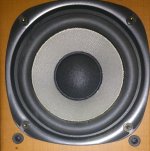I'm heavily into recycling, and loudspeaker technology hasn't particularly advanced in the last several decades. I'm toying with the idea of building a reclaimed driver database. The idea comes from commercial advances within the industry. There is no real market for small sub-woofer drivers. With the advent of micro-systems manufacturers were tasked with getting the maximum amount of bass out of the smallest possible driver in the tiniest of cabinets. (The fact that these cabinets are predominately ported is another conversation). The upshot is that any 4 or 5" bass driver in a micro-system speaker had a low Fs and Xmax to spare.
Now we are in a new commercial wave. The minions are purchasing wireless subs, throwing their old home theatre subs into the landfill. Without published T/S parameters the Air-fix crew won't touch them.
I have pulled the same driver from Sony, LG, Samsung, JVC, and Pioneer subs. I'm proposing a database to track these drivers.
e.g. Driver ABC1, used in systems: Sony32, Sansung11, JVC16, and Pioner23. TS Parameters:????
I think this could be a good resource.
Now we are in a new commercial wave. The minions are purchasing wireless subs, throwing their old home theatre subs into the landfill. Without published T/S parameters the Air-fix crew won't touch them.
I have pulled the same driver from Sony, LG, Samsung, JVC, and Pioneer subs. I'm proposing a database to track these drivers.
e.g. Driver ABC1, used in systems: Sony32, Sansung11, JVC16, and Pioner23. TS Parameters:????
I think this could be a good resource.
Attachments
The problem is that those drivers are very inconsistant and change over time in T/S parameters. They were build to be cheap and so not very high quality. I measured several the same type of drivers from Logitech Z5000 systems (they are actually Tang Band W8-670Q OEM-variations) and the parameters were very different from driver to driver. A friend wanted to use them in a bass array but at the end bought some peerless drivers for that. I think if you want to use that type of drivers, you should measure them one by one.
You're proposing self-defeating arguments. (1) Published T/S parameters vary by up to 20% - by specification: inconsistent.The problem is that those drivers are very inconsistant and change over time in T/S parameters. They were build to be cheap and so not very high quality. I measured several the same type of drivers from Logitech Z5000 systems (they are actually Tang Band W8-670Q OEM-variations) and the parameters were very different from driver to driver. A friend wanted to use them in a bass array but at the end bought some peerless drivers for that. I think if you want to use that type of drivers, you should measure them one by one.
(2) All drivers parameters change over time whether the driver be branded or not. Essentially, you are saying the parameters were only relevant on the day you built the system.
(3) You cite an OEM driver for which there is a retail equivalent - either, they are cheap, poor quality or they are not. OEM drivers are low cost to the brand because of the production run, not due to inferior quality. If Sony were to order from Tymphany they'd probably getting a 75% discount on account of they ordered a million units.
Yes, the database would only provide ball park information but every little helps.
When it comes to subjectivity: I have a 12 litre box in which I test 6.5" bass drivers. It provides options: sealed, ported 50Hz, ported 40Hz. The once popular Peerless SKO 165 performs poorly when compared to its unbranded counter parts.

